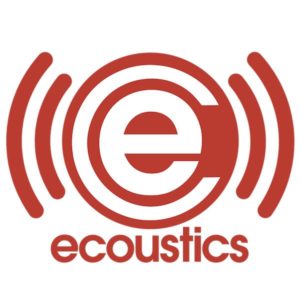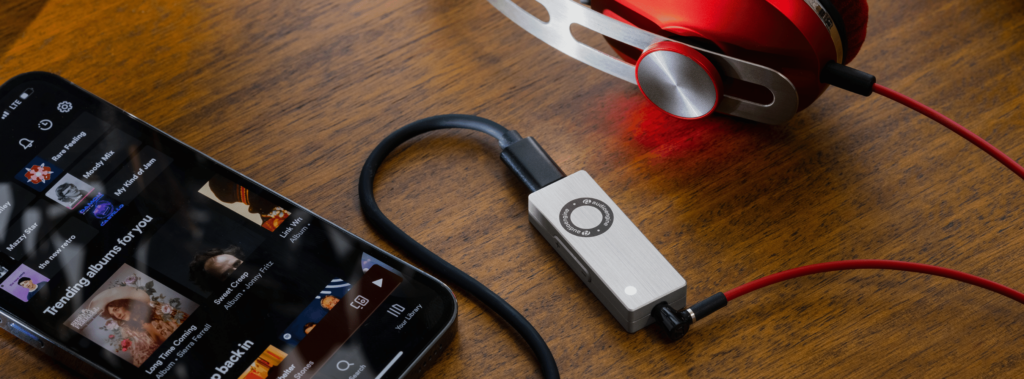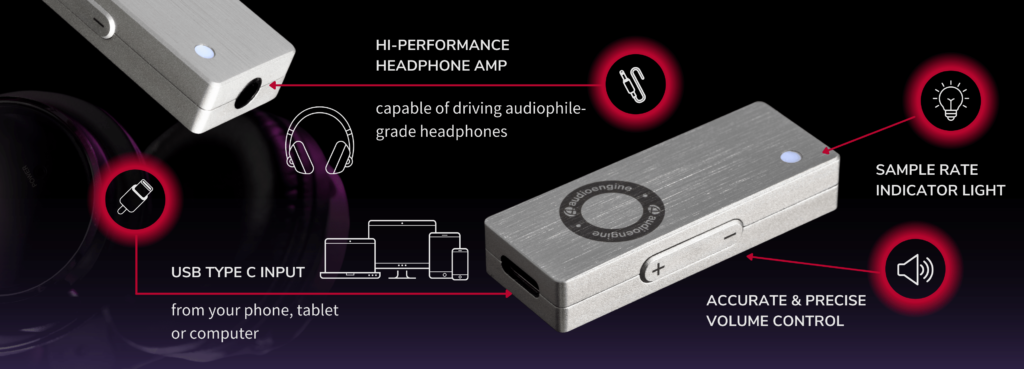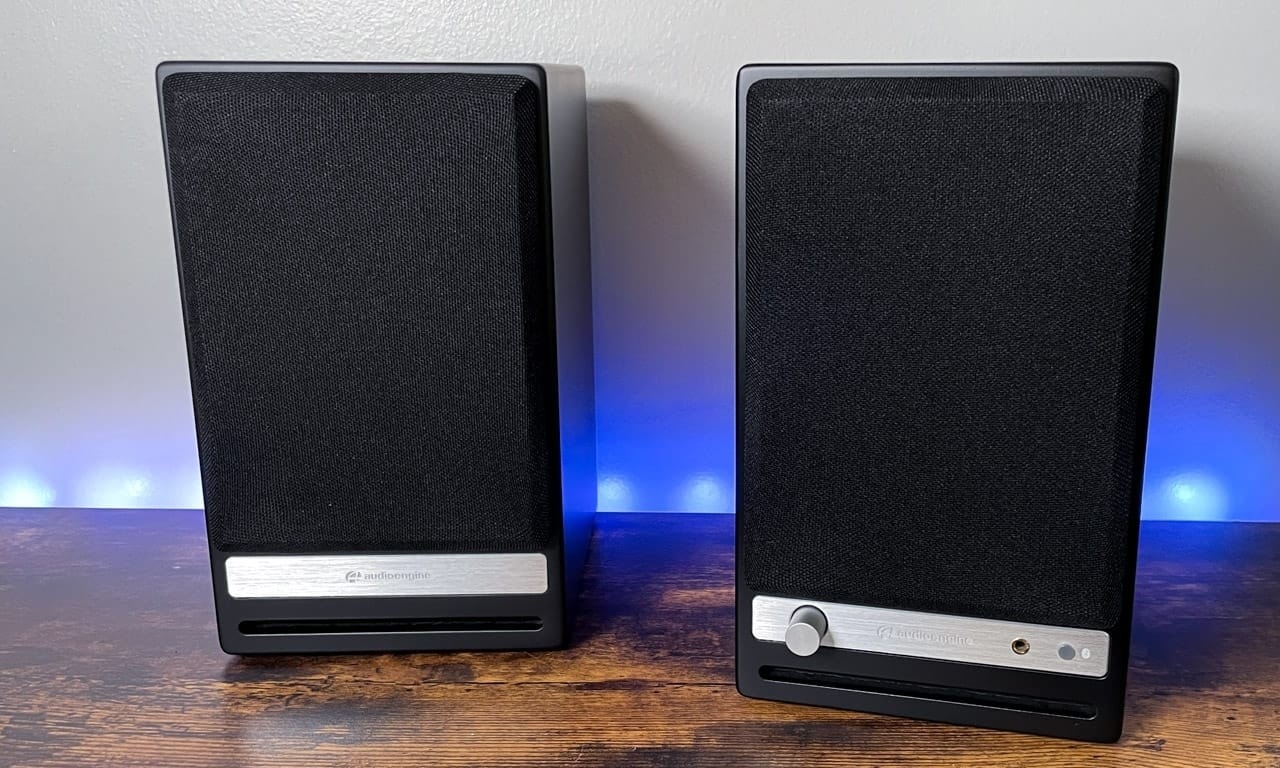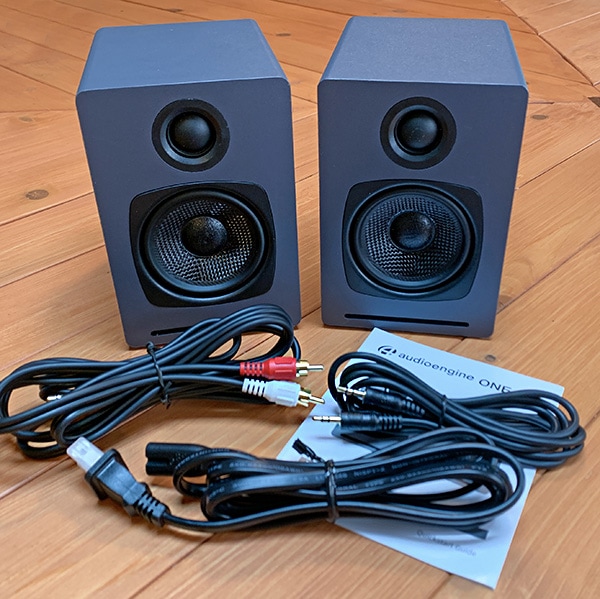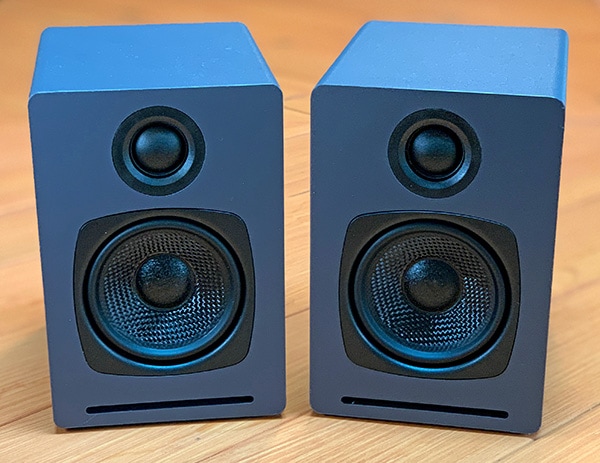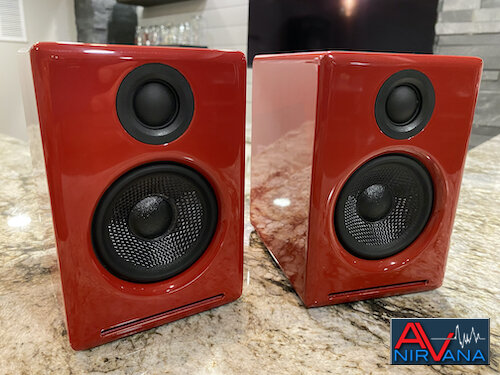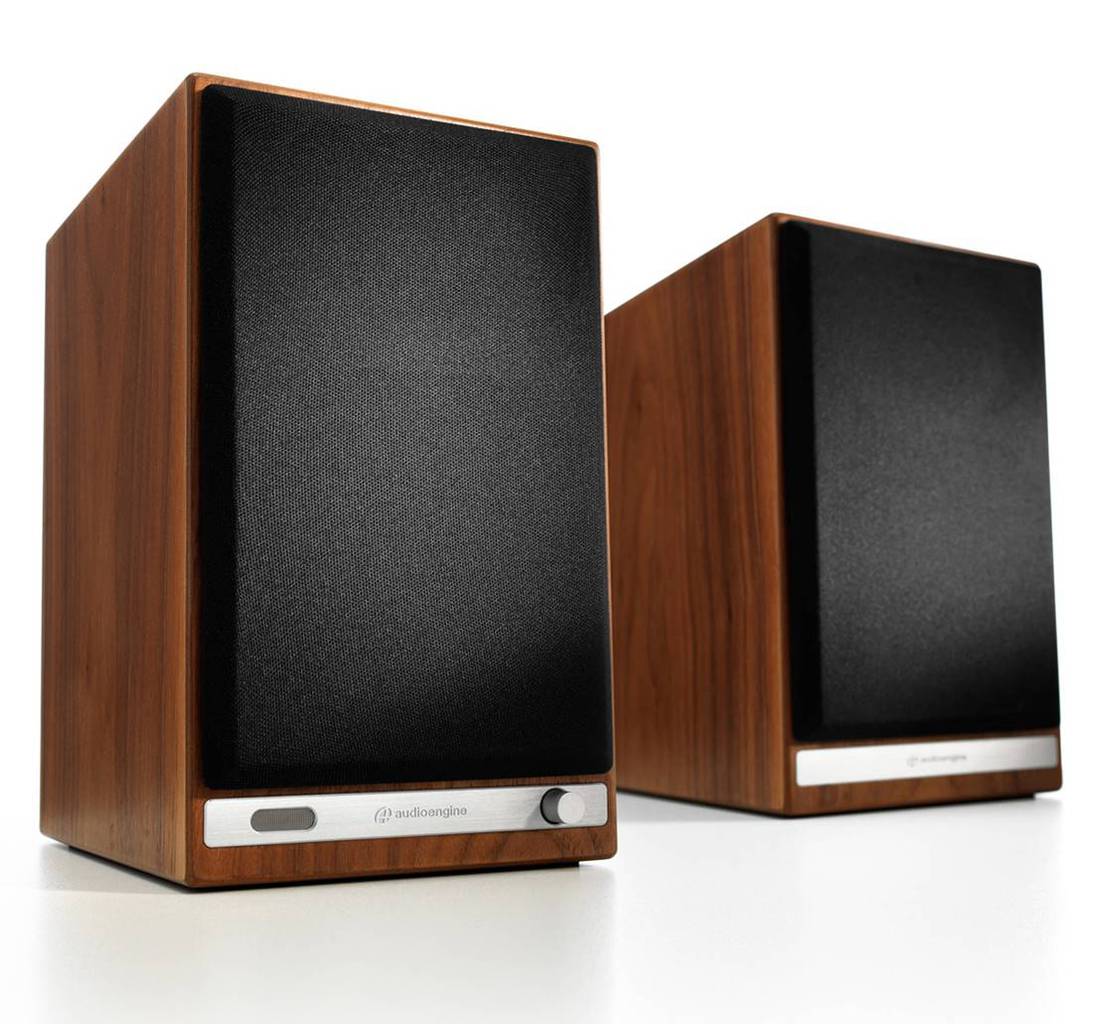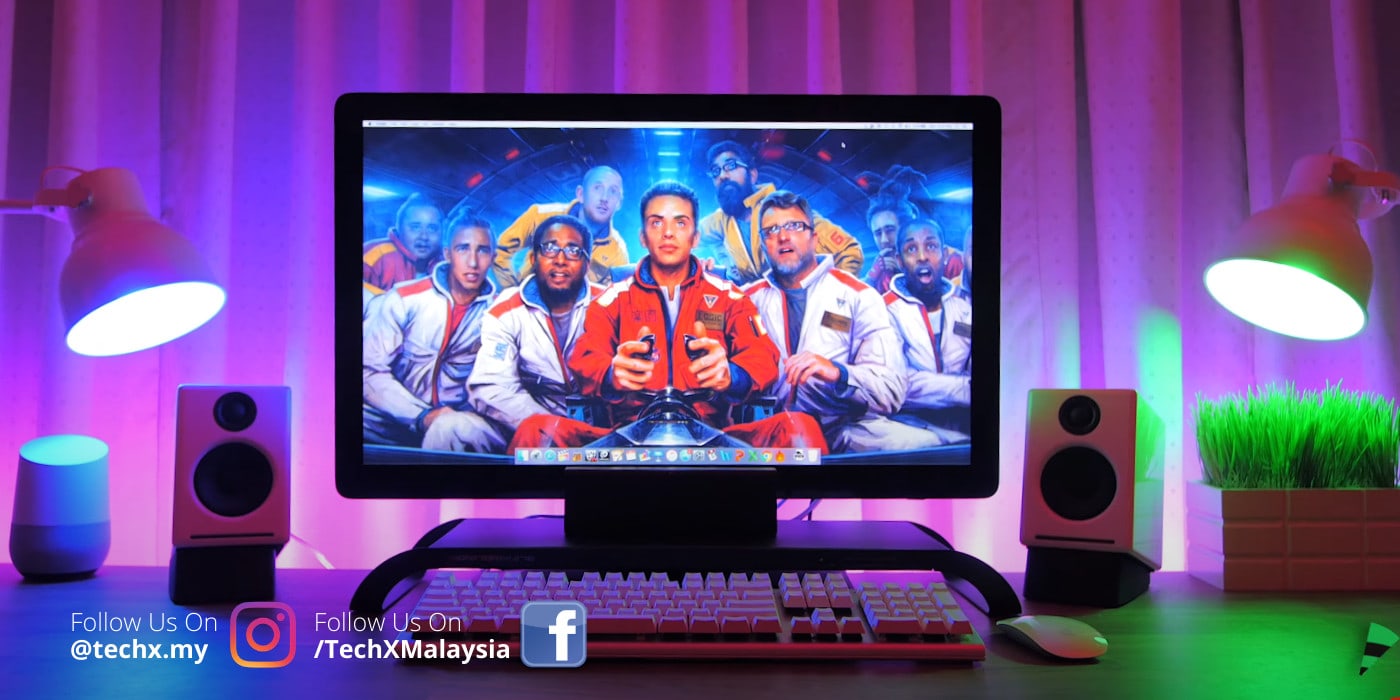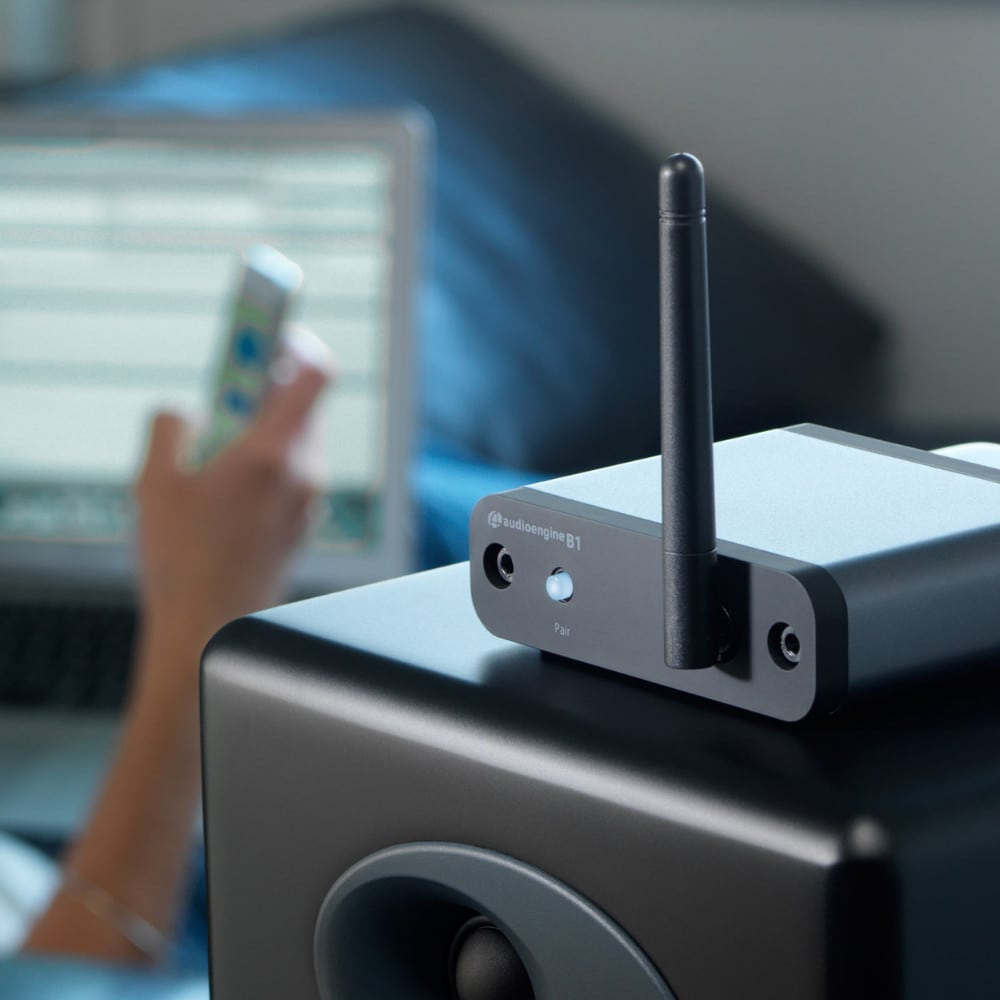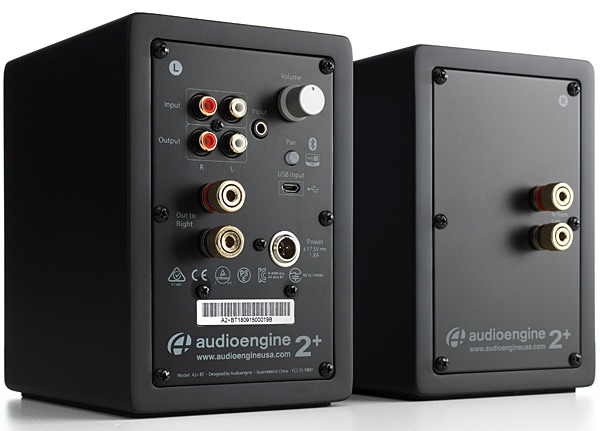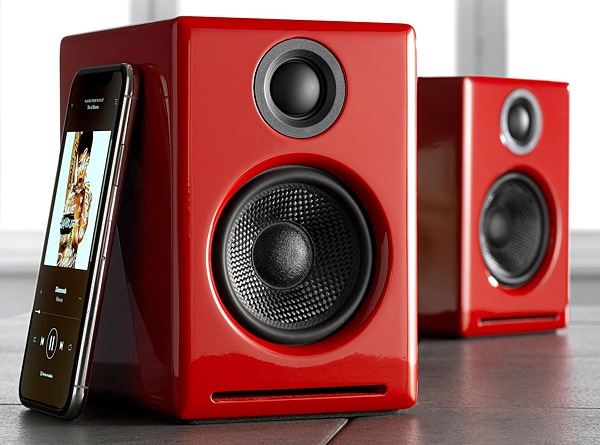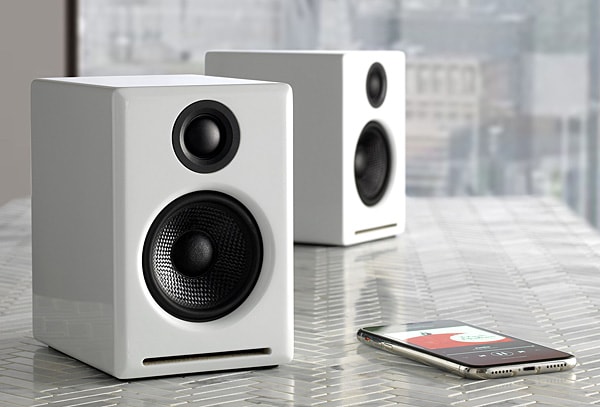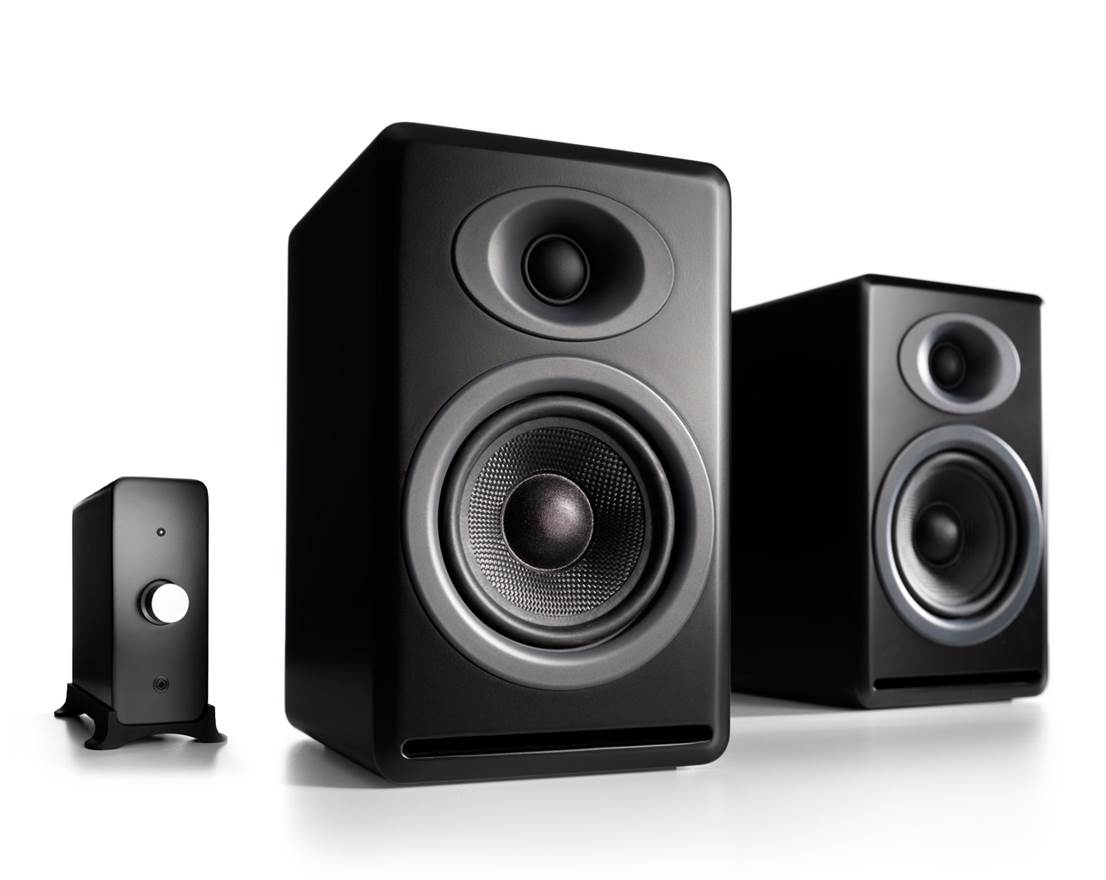Audioengine’s DAC3 Dongle DAC Can Drive Headphones and Powered Loudspeakers
The Audioengine DAC3 joins the growing ranks of affordable Dongle DACs for only $149.
Audioengine have announced a new Dongle DAC for 2022 with a rather attractive price tag. The Audioengine DAC3 will retail for $149.00 USD and is available now on their website.
Dongle DACs are all the rage right now, especially with the price of high-end DAPs breaking through the $3,000 USD price barrier. Very few consumers are willing to spend that amount of money on a DAP, but there are a few dozen options below $300 USD that might make sense for consumers who want a DAC/headphone amplifier that can be connected to their smart phone, tablet, or laptop and has the ability to drive either a pair of headphones or powered desktop loudspeakers.
Audioengine has a wide range of powered and wireless loudspeakers that can be connected to the DAC3 and the specifications suggest that it might be capable of driving a reasonable range of headphones.
DAC3 Internal Converter
The heart of the Audioengine DAC3 is the ES9281A PRO DAC, which is well-regarded for its low noise and high fidelity. Due to the high signal-to-noise specs of the ES9281A PRO and the added benefit of double redundancy power source conversion and filtering, the DAC3 presents impressive low noise and low distortion characteristics.
The DAC3 can decode up to 32-bit/384kHz PCM and DSD128. The Dongle DAC also supports MQA and will complete the final unfold of any MQA file.
DAC3 Headphone Amplifier
The Audioengine DAC3 contains a high-performance headphone amplifier based on the LME49726 low-noise opamp. This amp is able to provide low-impedance, high-fidelity audio and a 2-volt output which easily drives a wide range of headphones.
Until we actually try the DAC3 Dongle DAC with some less sensitive headphones from Audeze, Beyerdynamic, and Kennerton, we will not be able to verify the veracity of that claim.
The DAC3’s relay-controlled stereo output can also be connected to any system with an analog audio input, such as Audioengine powered speakers.
DAC3 Power
The DAC3 is powered directly from the USB bus and power is passed through two stages of regulation to ensure no USB bus power variations affect the audio quality. This low-noise, low-ripple power supply is located on a separate circuit board for extra isolation and thermal management.
Read the full article here.
GREAT CHOICE FOR MUSIC ENTERTAINMENT.
Everyone has their favorite companies for certain products. It’s what marketing professionals call “brand loyalty.” Brand loyalty is built over time and is nurtured through a strong sense of trust between the consumer and the product designer. Over the years, I’ve become a strong advocate for Audioengine. It’s a name that has always been synonymous with ‘quality’ for me. Since 2019, I’ve had the A2+ Wireless Speaker System powering my audio in my home office and just a few months ago, Audioengine released the HD4 Home Music System and I decided it was time for an upgrade.
DETAILS
The HD4 Home Music System is designed to round out the HD-series from Audioengine. The system is a wireless speaker system that also has wired options for audio inputs. The speakers produce high-fidelity audio that is ideal for smaller spaces. Audioengine packed the same technology that is inside the HD6 into the HD4 size. The speakers are housed inside hand-built wood-veneer cabinets that look great in any environment. The system features Bluetooth aptX-HD for premium, extended-range wireless audio. The speakers are easy to set-up. They don’t require any network connection or passwords. The speakers have a modern, compact design and can be connected to analog devices, such as turntables, as well as wireless devices.
USER EXPERIENCE
Audioengine has an incredibly easy set-up process and I was thrilled to find that with the HD4 system, they made it even easier. The speakers are accompanied by an antenna, speaker wire, a USB cable, mini-jack audio cable, RCA cable, cloth bags for all the accessories, and an AC power cord. The AC power cord was the kicker for me. One of the most annoying things to me when installing new devices into my workspace is having to work around a power brick. Even my last set of A2+ speaker had a power brick. Audioengine did away with that awful attachment and made it possible for the HD4 speakers to be powered by a single AC power cord. This automatically made the set-up infinitely more exciting to me.
To get the speakers set-up, you have to connect the two speakers using the provided speaker wire. This is another little touch of quality that I love about Audioengine. The speaker wire is wrapped and the ends have banana plugs installed. This makes plugging and unplugging the wire very simple. You don’t have to worry about getting the contacts just right or the ends getting frayed with continued use. The banana plugs help save the cable...
Audioengine HD4 Powered Bookshelf Speakers
The Audioengine HD4 Powered Bookshelf Speakers, featured in today's review is a premium all-in-one wireless speaker system that is compact and powerful. It sports the latest-and-greatest Bluetooth 5.0 spec and it supports aptX HD too. It accepts audio inputs from a 3.5mm mini-plug or a pair of RCA’s from a turntable or a TV. It allows you to connect a subwoofer, and there’s even a DAC onboard for connecting directly with computers over USB.
At $449.00 , it sits perfectly in-between its siblings — the HD3 and HD6. For its size and price-point, the HD4 completes Audioengine's award-winning HD series. We think it offers the perfect upgrade for a desktop, turntable, or main living room system where space is limited but performance cannot be compromised. We can’t wait to tell you more about its performance as a tabletop system and as a work from home setup.
Packaging, Design & Build Quality
In the box, three microfiber bags cover and protect everything. All the included cables are found in the smaller microfiber bag which includes everything needed to get up and running to hear music quickly. In the package, a pair of left and right banana connectors, a pair of left and right RCA cables, and a 3.5mm stereo mini-plug for connecting with a laptop or turntable’s built-in phono stage are included. If you want to take advantage of the HD4’s built-in DAC, you’ll need to source your own with the correct USB connections for use with your computer.
The HD4 Powered Bookshelf Speakers come in two color options. Our test unit arrived in a natural walnut MDF cabinet with a wood-veneer, but a more modern-looking black is also available. When we removed them from the microfiber protective bags, we noticed their simple but cool "old-school" look. The walnut features a minimalistic design with rounded corners that will add a touch of retro-flavored "warmth" to the style & decor of just about any room.
As usual with Audioengine products, the build quality is immediately evident. Similar to the more expensive HD6, the HD4 wireless is constructed with components that are custom designed in-house at the company’s Austin, Texas facility, and the MDF wood-veneer cabinets feel sturdy, and well-braced. The right speaker houses the amplifier, so it weighs 7 ½ pounds and the left speaker weighs about 5 ½ pounds.
What sets the new Audioengine HD4 apart from both the HD3 and HD6 is the size and price. Dimensionally, the HD4’s MDF cabinet stands right in-between its two siblings, standing 9-inches tall, 5 ½-inches wide and 6 ½-inches deep. This is substantially smaller than its bigger brother — HD6.
For comparison with the other speakers in the HD series, the HD3 is 3-inches shorter than the HD4, and 4 ¼-inches wide by 5 ½-inches deep. The bigger brother, HD6, is the largest in the series and stands 11 ¾-inches tall, about 7-inches wide, and 10-inches deep. Similar to the other speakers in the HD series, horizontal venting ports on the lower facades of both speaker cabinets are carved into the finished wood-veneer right below a brushed metal plate, which also features a cool engraving of the Audioengine logo.
Read the full article HERE
REVIEW – I’ve said it before that one of the more fun pleasures in reviewing products is finding that true bargain—something that is way better than the price would indicate. This time around, it’s the Audioengine A1 Home Music System. Along with the Tribit Stormbox micro speaker, the A1 speaker could be another bargain of the year.
What is it?
The Audioengine A1 Home Music System is a traditional two-speaker setup made for a smaller room or studio apartment. The speakers can be connected via traditional hard-wiring (3.5mm stereo mini-jack) or built-in wireless Bluetooth. They feature a digital hybrid amp, aramid fiber woofers coupled with silk tweeters. The amp and built-in digital audio converter (DAC) can handle digital files up to 48KHz sample rate at 16-bit depth—basically CD quality audio. The A1 handles Bluetooth 5.0 with up to 100 ft wireless distance. Nice.
Design and features
When I first read about them, I couldn’t figure where the Audioengine A1 speakers would fit within the Audioengine lineup. After all, the specs for the A2+ wireless speakers are nearly identical, yet the A1 is $70 cheaper. It turns out that all Audioengine did was take some of what they learned with the A2+ speakers and apply it to the A1—at a lower cost. Some may argue that the A2+ speakers still sound better, but unless you can do a side-by-side comparison, it may not be noticeable. Yes, there are fewer input options, a different amp setup, and no microfiber bags that other Audioengine speakers come wrapped in, but those are about the only noticeable changes.
A2+ Highlights: Affordable price point, compact, attractive cabinet finish, simple to integrate and operate, great overall sound.
Summary
The A2+ Wireless is Audioengine's latest A2 model, adding aptX Bluetooth to the mix for wireless performance. The speaker is well crafted, exhibits high-quality physical characteristics, and requires a small amount of space to deploy. Overall sound quality is very good, delivering an evenly tempered sound that's non-fatiguing. Bass output is somewhat restrained, but not to the detriment of playback.
The wireless audio segment is loaded with affordable speaker options, but there's a catch. More often than not, convenience and savings factors are marred by middling quality and playback capabilities. That’s why outfits such as Audioengine are appealing. Audioengine caters to convenience-seeking enthusiasts with a more refined engineering approach, delivering performance backed by in-house components and custom designs.
Last year, Audioengine added a new member to its offerings: the A2+ Wireless Speaker System (MSRP $269). This particular model builds upon the company's popular A2 speaker, replacing its Type B USB port in favor of Micro USB, while adding Hi-Fi aptX Bluetooth streaming. The resulting package costs roughly $50 more but adds a welcomed layer of convenience, allowing the A2+ to deploy as a desktop computer speaker or a standalone stereo pair on any surface with access to a power outlet...
Streaming music files used to be for listeners who cared more about quantity than quality. Times have changed. In the past ten years, various streaming services have begun offering files in resolutions of CD quality or above. At $189 USD, Audioengine’s B-Fi Multiroom Music Streamer offers a simple, inexpensive way to receive and distribute CD-resolution files. The B-Fi has dramatically changed the way I listen to music.
In the box
The B-Fi comes in a simple lift-top box, each of its contents occupying its own compartment molded into a single piece of Styrofoam: the B-Fi itself, a 42” stereo audio cable, a wall-wart power supply with detachable cord (USB Type-A to Micro), a microfiber storage bag, and a quick-start guide.
The B-Fi weighs only five ounces and is about the size of a pack of cigarettes: 3.5”W x 1”H x 3”D, or 3.75”H with its antenna pointing straight up. Its corner edges are gracefully rounded, and its aluminum case is white, with black plastic front and rear endcaps. The two bolts that hold the B-Fi together run all the way through the case, from front to back; the heads are plainly visible front and rear, giving it an industrial look. The pivoting antenna is permanently fastened to the front panel; other than that and the company and model names, the only thing on the front panel is an illuminated power button. On the rear panel are right and left analog outputs on two very-high-quality RCA jacks, a digital output (TosLink), and a jack for the 5VDC power supply. That’s it.
Built-in apps include those for iHeartRadio, Napster, Qobuz, QQ Music, Tidal, TuneIn, and Ximalaya -- units from the B-Fi’s second production run will also include Amazon Prime Music. That app and any future additions will be made available through a firmware update for earlier units. Apple AirPlay compatibility is included for accessing such third-party apps as Pandora and Amazon Music HD.
Via DLNA/UPnP, the B-Fi supports the file formats AAC, AAC+, ALAC, APE, FLAC, MP3, OGG, WAV, and WMA. The heart of the B-Fi is a 24-bit/192kHz ESS Technologies Sabre ES9023 DAC chip. Audioengine has limited the B-Fi’s use of this chip to 16/44.1.
The B-Fi doesn’t receive via Bluetooth -- it’s strictly a Wi-Fi streamer. Entirely wireless in operation, it lacks an Ethernet port for a wired connection to the Internet. It can be used with Audioengine’s free app, which is available from the Apple App Store or Google Play and requires an operating system of iOS 10.0 or later, or Android 5.0 or later.
Audioengine is a small independent company based in Austin, Texas. All of its support team are US-based, and they promptly answered my questions. They showed what a support team should be and seldom is.
Use
Setting up the B-Fi and getting it connected to the Internet was simpler and easier than with any other such device I’ve encountered. Download the Audioengine app, make sure an analog or digital interconnect is plugged into an input on your receiver, preamp, or powered speaker, follow the voice prompts to add the B-Fi to your Wi-Fi network, and you’re ready to start listening. From the app’s home menu you can choose Favorites, My Music, Search, or any one of the preinstalled streaming-service apps. The My Music option in the B-Fi app lets you access files stored locally on your phone, or from any DLNA/UPnP-enabled network attached storage (NAS) device.
Select one of the preinstalled apps and you’ll be taken to the home page of that streaming service. I tried Qobuz and Tidal for a while, but preferred Amazon Music HD and Primephonic, the latter a hi-rez service exclusively devoted to classical music. For these I had to open AirPlay; when I did, everything worked fine. The only problem I have with AirPlay is a delay of one or two seconds after you’ve commanded it to play a title but before that title starts playing. This is of no consequence once an album begins playing, as it doesn’t add any delay between tracks...
At first glance, it would be easy to wonder why a product like the Audioengine B-Fi exists in 2020—don’t most mobile devices now easily stream via Bluetooth to most speakers, multimedia streaming boxes, and newer televisions? Plenty do, but the $189 B-Fi is for gear, be it your home stereo or powered, non-wireless speakers, that lacks streaming functionality. Those familiar with the identically priced Audioengine B1, will recognize the B-Fi as, essentially, the Wi-Fi version of the Bluetooth B1. Its simplicity is perhaps its best selling point; within minutes, you can be streaming to speakers that lack wireless functionality over AirPlay or the Audioengine app, and the B-Fi will ensure the stream’s excellent sonic quality.
Design
Measuring 1 by 3.5 by 3-inches (HWD), with an antenna that extends 2.8 inches beyond the top panel when fully upright, the B-Fi is a tiny, unassuming box. You connect it to your wireless network via the Audioengine Connect app, and physically connect the ports on the back to your stereo gear over RCA stereo or optical. An RCA cable is included, but not an optical cable, which is a bummer. A status LED on the front lets you know when you’re connected or not—it’s also a button you press to initiate the wireless connection process.
The back panel also houses a connection for the included 5V power supply. The B-Fi employs an AP8064 ARM processor, and for digital-to-analog conversion, it utilizes the ES9023 DAC.
The free Audioengine Control app establishes a Wi-Fi connection with the B-Fi via your mobile device’s menu. Once this connection is made, you choose which wireless network you want the B-Fi to stream over, and then you can name the system if you wish. You can group multiple B-Fi units together, or independently assign different ones to different speaker systems within your wireless network.
The app controls are simple and spare, letting you adjust volume and left/right balance (for stereo connections). Within the app, tapping on your system’s name accesses your phone’s locally stored music, as well as services like Apple Music, Spotify, and Tidal. The app is graceful and even features a cool spinning record graphic that incorporates the album art for whatever is playing—the rare design touch in an app that enhances the visual experience.
The B-Fi is compatible with AirPlay, DLNA, and UPnP streaming. Once you name the streamer, it’ll appear in the AirPlay menu of available speakers when you tap its icon on your iOS or macOS device. Interestingly, there’s no support for AirPlay 2—Audioengine decided that the multiroom grouping functionality already built-in to the B-Fi via its app was sufficient...
Summary – Audioengine HD6 Review
When it comes to bookshelf speakers, I have to confess that the Audioengine HD6s have some of the best sound I have ever heard. They are essentially bookshelf speakers like the KEF LS50, and are powered speakers with an integrated DAC system for high performance audio reproduction. The HD6 Bluetooth speakers built-in analog power amplifiers and are also equipped with an aptX HD Bluetooth codec with a 100 foot range and 24-bit DAC which allow you to bypass low-quality sound cards in your laptop or PC devices for premium sound performance. They are wireless and work with all your smartphone devices and apps, and requires no additional network setups. It delivers high-end sound wrapped in hand-built wood cabinets without any receiver required. The HD6 speaker supports aptX HD Bluetooth codec, subwoofer connections and even has a remote control to go with it.
Technical Specifications
Most importantly, the Audioengine HD6 works with turntable and built-in external pre-amps so that you can get the best sound quality out of these speakers. They are also TV supported with analog outputs and RCA output connectivity.
The HD6 speakers have a 150W peak total power (50W RMS, 75W peak per channel). They come with 5.5” aramid fiber woofers and 1” silk dome tweeters for crystal clear sound performance. The speakers support Bluetooth 5.0 for high-quality music streaming with an input bit depth of 24-bits up-sampled.
How do these speakers sound?
You’ll fall in love with the sound quality of the Audioengine HD6 speakers. They produce some of the best sound I have heard in a long time, with tonal clarity, maximum depth and superb soundstage. The level of depth that these speakers can go is out of this world – you’ll hear things in your music which you have never heard before through these speakers. Vocal performances sound natural and very well-amplified, giving you a sense of where the vocalist is standing in the room. The highs and midranges are phenomenal – they sound detailed in almost every respect with presence and authority. The treble and midbass is well-articulated and balanced; they are strong enough for you to forego a dedicated subwoofer when using these speakers.
Listening to classical and instrumental music with these speakers was a very satisfying experience. You must use a turntable together with these speakers to appreciate how good these speakers actually are in terms of detail. Forget the wireless Bluetooth connection from your smartphone as this wouldn’t do justice to these speakers. Mozart and Beethoven sounded spectacular on these bookshelf speakers, giving you a sense of where each instrument is originating from with refined precision.
Design & Construction
The HD6 speakers come with custom 5.5” Kelvar woofers with die cast aluminium woofer baskets, and a custom 1” silk tweeter with neodymium magnets and ferrofluid-cooled voice coils. They are housed in hand-built cabinets with furniture-grade finishes and detachable magnetic speaker grills. It also has threated inserts to secure the speakers to stands. There are also passive crossovers with upgraded components for crystal clear sound distribution.
The Verdict?
The Audioengine HD6s are primarily designed for audiophiles who want high-fidelity sound in a bookshelf setting. These are highly versatile speaker with multiple connectivity options including optical, Bluetooth, RCA, analog and turntable connections. We also liked how good these speakers sounded, with crystal clear highs, very detailed midranges, midbass and deep bass performance. The sound quality from these speakers is near-perfect – everything sounds realistic and detailed with absolutely stunning soundstage. There’s also plenty of detail and depth in the music that makes these speakers stand out. If you are looking for a thoroughly satisfying audio experience, definitely go for the Audioengine HD6 speakers.
Looking for desktop speakers that sound great, are easy to use and makes you want to listen to your music collection everyday? If yes, chances are you've come across Audioengine A2+ Desktop Speakers and A5+ Powered Bookshelf Speakers before. Audioengine is one of the well-known American brands that is committed to offer high quality powered speakers to deliver music as they were meant to be heard. It offers a wide range of wireless powered speakers, desktop amplifiers, DACs and accessories. Here, in today's article we are going to discuss Audioengine A2+ and A5+ speakers, their specifications, audio quality, strengths and pitfalls, customer reviews and where you can buy Audioengine speakers in Malaysia. Let's explore...
Where Audioengine is based, and is Audioengine speakers any good?
Audioengine is a leading speaker company based in Austin, Texas. Founded back in the year 2005, its mission is to help you rediscover your music passion and appreciate it with the highest sound quality. Both Audioengine founders, Brady Bargenquast and Dave Evans, are ardent music enthusiast who aspires to change the way people listen to music everyday. Audioengine bookshelf speakers and audio accessories are inspired by you and how you listen to music. In our opinion, the Audioengine speakers are minimalist, stylish, delivers a fun near-field listening experience & highly detailed three-dimensional soundstage for its price!
Even if you’re not an audio enthusiast we guarantee your music will sound better! (Audioengineusa)
Audioengine speakers deliver a stellar sonic experience aimed at audiophiles with 24-bit upsampling to ensure high-quality Bluetooth audio! (Time Gideon – Author at pcmag.com)
Looking to upgrade your desktop audio system? Can’t go wrong with Audioengine speakers! Their speakers have been getting rave reviews from professional reviewers as well as consumers. (TechX Malaysia)
Review: Audioengine A2+ vs A5+
Audioengine A2+ Review
What can you get with this speaker?
- ¾ inch Silk Dome Tweeters
- 2 ¾ inch Aramid Fiber Woofers
- TI PCM2704 DAC chip
- Dual Class AB monolithic amplifier
- 3.5mm, RCA, USB, Bluetooth (Inputs)
- 15W RMS/ 30W peak per channel
The Audioengine A2+ speaker is an update to the old A2 speaker. What makes it different from the original A2 speaker is an integrated DAC as well as a variable output by which you can easily add a subwoofer. It is a powered speaker which means that it works without an amplifier or a receiver. With its USB audio input, it receives a clean signal from your laptop/desktop and delivers enhanced near-field listening experience.
Now, let's explore how this speaker sounds
These speakers were developed with desktop use in mind. These are not for somebody who likes a lot of bass or listens at a loud volume or listens to fairly complex music. This is going to be more for somebody who listens to fairly simple music i.e. vocals, chamber music, jazz, quintet and the occasional pop track. It’s also for someone who values speakers delivering exceptional clarity and a wide soundstage.
For sound signatures, they do take on the V-shaped, meaning the treble and bass is going to boosted a little. Despite having an overall presentation that resides in the forward if not slightly thin side of neutral, they’re still enjoyable on mediocre recordings, which is pretty cool. These are fairly transparent speakers, feed good quality recordings and the treble will be lively, forward, very listenable if not even smooth sounding. The upper mid-range is going to be a little bit thin, but the tone is still very pleasant. After 40 or 60 hours of break ins, the bass tones down but you’re not going to get much below 100Hz. The bass is going to take a warm character, for something at this size isn’t necessarily a bad thing.
The strength of these speakers is when you play high fidelity recordings with vocals. They sound phenomenal, the tone clarity and the sense of scale is almost properly audiophile. You’ll be able to discern the tiniest nuances of a recording. The sound imaging is very holographic in a desktop environment, very well focused in between the speakers where it almost sounds like its coming from behind a monitor...
I usually go swimming weekly during the summer months. Swimming is a great way to cool down from the heat of the day, not to mention the place where I work -- the University of Calgary -- has an excellent lane swimming facility that I have unlimited access to. Of course, I only go swimming recreationally; I am by no means anywhere close to being the best swimmer of the bunch -- my Bronze Cross certification I got more than a decade ago is for lifesaving rather than competition. As such, I usually swim in the slow lane to not hold people back. One time, when I was swimming in the slow lane, someone put on flippers and started doing laps. For those who has swam with flippers before, your speed is pretty much multiplied. I did not understand why he stayed in the slow lane because he was at least twice as fast as everyone else. Eventually, I got annoyed and told him to move over to the next lane since he kept running into everybody. I think what he needs to understand is that flippers, albeit a small addition to your feet, makes such a big difference in your speed that puts you in a whole different category of performance. Almost six years ago, I reviewed the Audioengine A2+, a pair of speakers I said were "incredible; bar none". Fast forward six years and we have the Audioengine A2+ Wireless here at APH Networks, but with a small addition: Wireless capabilities. Will adding wireless to the A2+ make it all the better like adding flippers to your feet when swimming? Read on to find out!
Our review unit of the Audioengine A2+ Wireless did not arrive from California, USA like majority of the products we review here at APH Networks. Instead, it came from Delta, BC, Canada, which is a city in the Greater Vancouver Area that borders Point Roberts, Washington. Audioengine's Canadian distributor, Atlantia, provided us with the sample for review, just like it has been in the past. Using a medium-sized brown corrugated box and traveling via FedEx Standard Overnight, everything arrived in excellent condition to us one province over to the east in Calgary, Alberta for our evaluation today.
Audioengine still uses the same general retail box design template as they did six years ago with the A2+. There were a few minor modifications made, but you would be hard pressed to identify the difference unless you look at them side-by-side. From our photo above, Audioengine keeps the packaging simple, just like the speakers. All you will get is the branding with model at the top, a photo of the speakers in the middle, and a line that describes the product at the bottom. That is it. On the other side, you will get the exact same thing. Stuff like its color and specified region is found on a label.
Before we move on, let us take a look at the specifications of the Audioengine A2+ Wireless, as obtained from the manufacturer's website:
General specifications
Type: 2.0 powered (active) multimedia desktop speaker system
Amplifier type: Dual class AB monolithic
Power output: 60W peak power total (15W RMS / 30W peak per channel), AES
Drivers: 2.75″ aramid fiber woofers, 3/4” silk dome tweeters
Inputs: 3.5mm stereo mini-jack, RCA, USB, Bluetooth
Outputs: RCA variable line-out
Mains voltages: 100-240V 50/60Hz auto-switching
SNR: >95dB (typical A-weighted)
THD+N: <0.05% at all power settings
Crosstalk: <50dB
Freq. response: 65Hz-22kHz ±2.0dB
Input impedance: 10K ohms unbalanced
Protection: Output current limiting, thermal over-temperature, power on/off transient protection
Connector type: Micro USB
USB device class: type 1.1 and above
Internal D/A converter: CSR8670
Input bit depth: up to 16 bits native
Input sample rate: up to 48KHz native
Bluetooth specifications
Internal BT receiver: CSR8670
Input bit depth: 16 bits
Bluetooth receiver type: Bluetooth 5.0 audio
Supported codecs: aptX low latency, aptX, AAC, SBC
Wireless operation range: Up to 100ft (30m) typical
Input data rate: Determined by Bluetooth
Wireless latency: ~30 milliseconds (ms)
Weights and measures
Dimensions (each): 6”(H) x 4”(W) x 5.25”(D)
Weight (LEFT speaker): 1.6Kg/3.55lbs
Weight (RIGHT speaker): 1.4Kg/3.15lbs
Shipping weight: 4.6kg/10lbs per pair
Shipping box dims: 10.5” (H) x 15” (L) x 7” (W)
The Audioengine brand, as a whole, is known widely for their professional speakers and audio equipment, so you’d expect pro-calibre quality in the B1 too, and it delivers. It’s a device aimed at two people: audiophiles who want the best analog audio treatment and top-notch compression codecs, and audio professionals. If you’re running a studio, you probably have studio monitor speakers, but if your clients want to quickly stream an audio example during a working session, having a high quality option that folds right into your pro setup (and doesn’t undercut the quality of your speakers) could be super-handy. Here’s how this thing breaks down.
Audioengine B1 Bluetooth Music Receiver
Lifewire / Jason Schneider
Design: Sleek, utilitarian, and substantial
The first thing you notice about this receiver is the visible and obvious antenna sticking out the front. This part of the build is there for a very functional purpose (we’ll get to that later), but it adds a distinctive aesthetic flair, because most Bluetooth receivers don’t have an antenna at all. Other than this, it’s pretty small and sleek.
Most of the chassis is brushed, slate grey metal. The front and back plates that contain all the I/O and controls are dark gray or straight black. The on/off button on the front doubles as the Blue LED indicator, and the AE logo is painted on in a soft white. This makes for a pretty futuristic look, more of a statement than the majority of the options in this category.
Durability and Build Quality: Solid and rugged, even the antenna
It’s weird to say about a Bluetooth receiver that will largely sit on a shelf for its lifetime, but we were very impressed with the build quality of the B1 when we unboxed it. Because most of the chassis is made of aluminum, it feels really solid with hardly any give. It weighs right around a pound, and that heftiness works to the device’s advantage because once you set it down on the firm rubber feet it stays in place.
The B1 gets top marks on build quality, a look and feel befitting its price.
Even the antenna is built of a thick, unbendable rubber material. The button is satisfyingly clicky, and the I/O hacks on the back felt perfectly stable, particularly with the high quality included cables. The B1 gets top marks on build quality, a look and feel befitting its price.
Setup Process and Connection Stability: Solid signal with impressive range
The Audioengine B1 appeared on our Bluetooth lists as soon as we put it in pairing mode, great to see from a device that costs this much. With Bluetooth 5.0, you’ll have the most modern protocol at your disposal, but what’s really interesting here is the inclusion of the antenna alongside what AE is calling “careful antenna tuning”. This means you’ll get an advertised 100 feet out of range out of the device.
While this might seem excessive (who has a 100 foot room?), what we found nice about this is that we could beam music from two rooms over through thick concrete walls on Bluetooth with no problem. This is virtually unheard of for basic Bluetooth connectivity, and it was really amazing how well it work. Needless to say, you won’t need to worry about dropouts with this signal strength.
I/O and Controls: Simple controls and well-appointed connection options
The controls on the device are pretty simple—literally one button on the front of the receiver. This is a welcome contrast to other premium options in the category, which tend to lean on bloated switch arrays and app connectivity.
The I/O available here is pretty solid, too. The B1 takes power via an included 5V micro USB input, and there’s the standard dual-color analog RCA jack on the back for transmitting audio to most household speakers. But they’ve also included a digital optical SPDIF output so you’ll be able to set this up with even your more advanced stereo receivers. This latter point will become particularly important when we get into sound quality, because it ensures that all the audio this device is supporting can be transmitted through the optimal output.
THE VERDICT
The Audioengine A2+ combines audiophile-friendly sound with the convenience of Bluetooth to create a broadly appealing compact speaker package.
Audioengine is well-known for making affordable powered and passive speakers that are compact enough for desktop use. Like several of the company's previous offerings, its most recent model, the A2+, is a petite powered speaker with multiple connectivity options, including wireless aptX Bluetooth streaming. What makes it stand out from other Audioengine speakers? The price: at $269, the A2+ is the least expensive powered Bluetooth model in the company's lineup.
Other than being affordable, there's lots to like about the A2+. Build quality is exceptional for a speaker at this price, and Audioengine offers satin black, high-gloss red, and high-gloss white finish options.
The A2+ system's left-channel speaker contains a 2 x 15-watt RMS (30-watt peak) class-AB amplifier and links to the right- channel extension speaker via an included 6.5-foot length of speaker wire. Cabinets are vented by a slot located near the bottom of the front baffle, and the driver array consists of a 2.75-in aramid fiber woofer and 0.75-in silk dome tweeter. Connections and controls are located on the left speaker's back panel and include stereo RCA and mini-jack inputs, a mini USB input (the built-in DAC can decode up to 24-bit/48kHz files), and a stereo RCA subwoofer output. Lastly, there's a volume knob that also powers the system on/off.
Setup and Use
The system's ultra-compact form factor made it a natural fit for my desktop. I first plugged in the external power supply and connected it to the left speaker, then placed both speakers on a riser to elevate their tweeters to ear-level. The distance from the wall behind my desk was 8 inches. Sources included a MacBook Pro running Roon for playback and connected directly to the USB input plus the same computer feeding data to a 24-bit/192kHz-capable Meridian Explorer DAC. I also tried a Bluetooth link to confirm the specified 100-foot range (confirmed!).
No remote control is included with the A2+, though I didn't find that to be a problem. I did lament the lack of a front-panel volume knob. Sometimes you want to reach out and make quick adjustments when listening as opposed to fumbling for a software volume slider. Input switching is automatic, or, to be more precise, multiple inputs on the speaker can be active at once, letting you handle source selection externally.
Performance
I started off my listening session by streaming a 24-bit version of Marissa Nadler's "For My Crimes" from Qobuz, at first via the speaker's USB input, and then using the Meridian DAC. Noise with the analog input active proved vanishingly low. Nadler's guitar had a clear, glistening quality, and her voice sounded at once warm and textured. The speaker's pinpoint imaging allowed the song's strings and background vocals to spread wide across the soundstage, and I could hear a distinct sense of layering between these background elements and the vocals.
Listening next to a 16/44 Tidal stream of Brad Mehldau's "Little Person," the piano had a similarly warm, yet detailed presentation, and the song's lightly brushed cymbals displayed just the right amount of sizzle without coming off as edgy. Despite the speaker having tiny 2.75-inch woofers, I heard more than a suggestion of low end; the sound could best be described as well-balanced.
Playing another 16/44 Tidal stream, Mussorgsky's Pictures at an Exhibition: The Great Gate of Kiev, as performed by the Cleveland Orchestra conducted by Oliver Knussen, the system's sound could get a bit congested at high volumes, but it overall proved capable of conveying an orchestral performance with good density and spatial detail.
Conclusion
Audioengine's A2+ is the kind of desktop system that lends itself to long listening sessions. Its sound is warm and inviting, yet clear, making it a good match for acoustic music. And while the lush, spacious sound put out by the A2+ makes it an obvious choice for audiophiles, features such as Bluetooth and a USB computer input also make it a fine option for a less fussy listener...
Read full article here.
Audioengine P4 Review
The Audioengine P4 is a class of its own and a really solid set of bookshelf speakers you can find from a pure sound performance angle. It is essentially a 2-way passive, high performance bookshelf speaker pair with great looks and sound quality but without the need for external amplifiers. These speakers come with gold-plated 5-way binding posts, silk dome tweeters with Kevlar woofers which are magnetically-shielded, as well as a frequency response of 58Hz-22kHz. They are compact, durable and aesthetically one of the best bookshelf speakers we have come across, making them ideal for your living room, bedroom or office or as a surround speaker for your home theatre system. The P4s come in three options: black, white and solid bamboo. While the Audioengine P4s comes with an arguably higher price tag, they are definitely bookshelf speakers that are worth investing in if you want to upgrade your stereo sound system.
The Pros & Cons
The Pros. The Audioengine P4s deliver some of the best sound performance we have heard, with great attention to detail and forward-type sound that projects clear sound quality at every level. Listening to the P4s feels as though you are listening to a larger high end stereo system.
The Cons. The Audioengine P4s, while sonically great, come with a hefty price tag. The size of both stereo speakers can be a little bulky for smaller bookshelves or tables.
Sound Performance
To be clear, the P4s are spectacular speakers that specialize in detail, forward-type sound and bring all the music detail without being loud. We reviewed this speaker while listening to classical pieces and the notes came out smooth and superb, which clear details present at every level. The P4 provides a crisp, forward, detailed sound without the need for excessive volume, and these drivers deliver the quality of sound that we were looking for – we were blown away by the clarity and resolution of these best bookshelf speakers. The P4s have hands down some of the best soundstage from bookshelf speakers and the level of separation of detail and instruments were incredible.
The P4 is essentially a system that improves with age. The sounds are very subtle and you could almost feel as though you were listening to a much larger bookcase speaker/powered amplifier system. The P4s also work very well when combined with Audioengine’s S8 subwoofer which adds a little more depth to the bass output. Audioengine even has a dedicated engineer who would be able provide assistance by taking questions and helping with technical issues with your Audioengine equipment, which makes things much more convenient.
Miscellaneous
The P4s can also connect to tube amplifiers to enhance the sound output – the P4s can handle perfectly loud music without distorting, while allowing all the music properties to remain the same. The P4s are very full sounding speakers and have a small footprint but the sound presence produced by these speakers is truly something to behold. In short, the P4s are so much more listenable and easier to setup than a 5.1 system and yet the sound stage they create is so lifelike that it feels as though you are in a 5.1 setup. We have great experiences reviewing the P4s while watching blu-ray movies and simply listening to music on these speakers – and we are happy to conclude that the P4s are well and truly some of the clearest and best sounding bookshelf speakers you can find. If you listen to vinyl records, the P4s will bring out the details in your music with crystal clarity.
The Verdict?
The P4s are bookshelf speakers that excel in terms of producing forward-type detail and crystal clear sound that are best suited for those who enjoy listening to every detail in their music. The P4s produce phenomenal clarity, resolution and musical detail without being loud. Despite their small size, they put out so much sound and power especially with vinyl soundtracks. That said, the P4s alone may require an additional subwoofer to connect to it (such as the Audioengine S8) to enhance the bass response if you enjoy bass heavy soundtracks. Other than that, we couldn’t be more pleased with these speakers and for the price they are hands down one of the best bookshelf speakers you can get. These bookshelf speakers well exceeded our expectations and we highly recommend them.
Be sure to check out our top picks for the best bookshelf speakers that deliver quality sound performance with crisp highs and deep bass response.
Read full article here.
